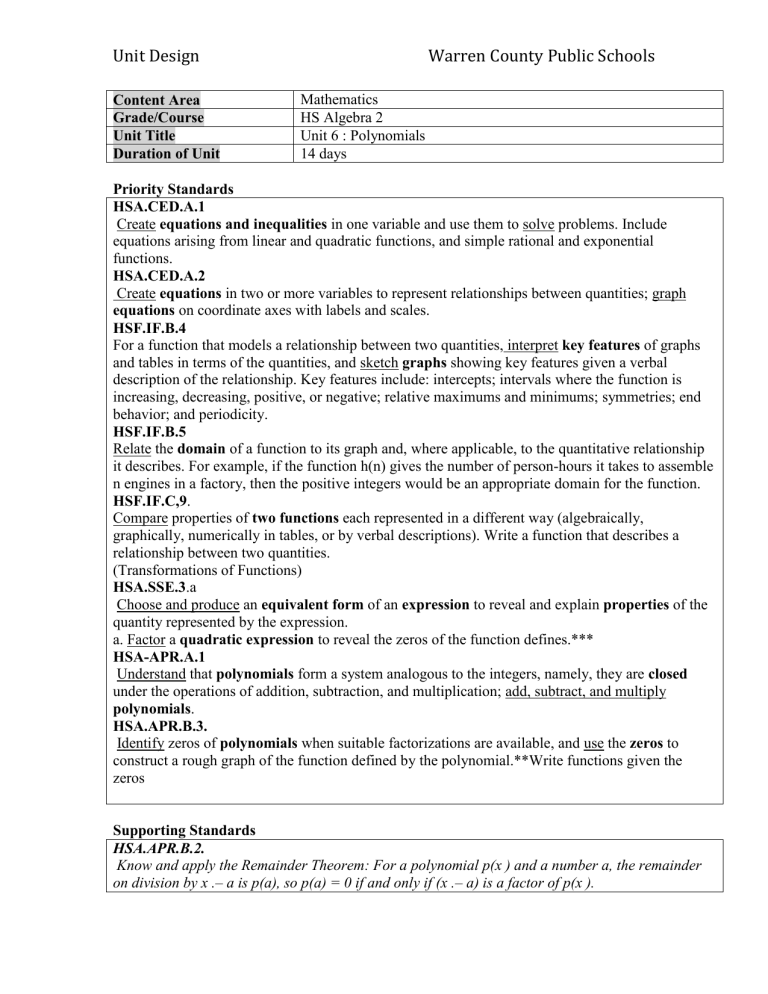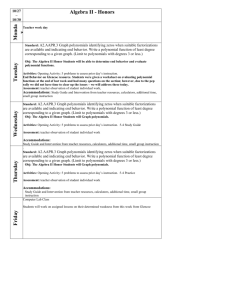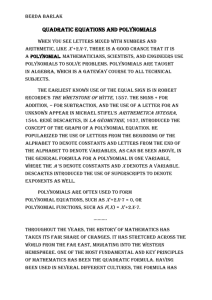Content Area

Unit Design Warren County Public Schools
Content Area
Grade/Course
Unit Title
Duration of Unit
Priority Standards
HSA.CED.A.1
Mathematics
HS Algebra 2
Unit 6 : Polynomials
14 days
Create equations and inequalities in one variable and use them to solve problems. Include equations arising from linear and quadratic functions, and simple rational and exponential functions.
HSA.CED.A.2
Create equations in two or more variables to represent relationships between quantities; graph equations on coordinate axes with labels and scales.
HSF.IF.B.4
For a function that models a relationship between two quantities, interpret key features of graphs and tables in terms of the quantities, and sketch graphs showing key features given a verbal description of the relationship. Key features include: intercepts; intervals where the function is increasing, decreasing, positive, or negative; relative maximums and minimums; symmetries; end behavior; and periodicity.
HSF.IF.B.5
Relate the domain of a function to its graph and, where applicable, to the quantitative relationship it describes. For example, if the function h(n) gives the number of person-hours it takes to assemble n engines in a factory, then the positive integers would be an appropriate domain for the function.
HSF.IF.C,9 .
Compare properties of two functions each represented in a different way (algebraically, graphically, numerically in tables, or by verbal descriptions). Write a function that describes a relationship between two quantities.
(Transformations of Functions)
HSA.SSE.3
.a
Choose and produce an equivalent form of an expression to reveal and explain properties of the quantity represented by the expression. a. Factor a quadratic expression to reveal the zeros of the function defines.***
HSA-APR.A.1
Understand that polynomials form a system analogous to the integers, namely, they are closed under the operations of addition, subtraction, and multiplication; add, subtract, and multiply polynomials .
HSA.APR.B.3.
Identify zeros of polynomials when suitable factorizations are available, and use the zeros to construct a rough graph of the function defined by the polynomial.**Write functions given the zeros
Supporting Standards
HSA.APR.B.2.
Know and apply the Remainder Theorem: For a polynomial p(x ) and a number a, the remainder on division by x .– a is p(a), so p(a) = 0 if and only if (x .– a) is a factor of p(x ).
Unit Design Warren County Public Schools
HSA.APR.D 6.
Rewrite simple rational expressions in different forms; write a(x )/b(x ) in the form q(x ) + r (x )/b(x
), where a(x ), b(x ), q(x ), and r (x ) are polynomials with the degree of r (x ) less than the degree of b(x ), using inspection, long division, or, for the more complicated examples, a computer algebra system.
HSA.REI.D11.
Explain why the x-coordinates of the points where the graphs of the equations y = f (x ) and y = g(x
) intersect are the solutions of the equation f (x ) = g(x ); find the solutions approximately, e.g., using technology to graph the functions, make tables of values, or find successive approximations.
Include cases where f (x ) and/or g(x ) are linear, polynomial, rational, absolute value, exponential, and logarithmic functions
HSF.IF.A.2
.
Use function notation, evaluate functions for inputs in their domains, and interpret statements that use function notation in terms of a context
HSF.IF.C.7c
Graph functions expressed symbolically and show key features of the graph, by hand in simple cases and using technology for more complicated cases. c. Graph polynomial functions, identifying zeros when suitable factorizations are available, and showing end behavior.
HSF.BF.B.3.
Identify the effect on the graph of replacing f (x ) by f (x ) + k, k f (x ), f (kx), and f (x + k) for specific values of k (both positive and negative); find the value of k given the graphs. Experiment with cases and illustrate an explanation of the effects on the graph using technology.
HSN.CN.C.8 (+ )
***(not covered in ACT Course Standards) Extend polynomial identities to the complex numbers.
For example, rewrite x2 + 4 as (x + 2i)(x – 2i).
Concepts (nouns)
Equations &
Inequalities
Skills
Create
(verbs) Bloom’s Level (verb)
Create
Graph
Represent
Interpret
Apply
Understand
Analyze
Equations
Constraints
Solutions & Key
Features
Graphs
Domain
Two Functions
Quadratic
Polynomials
Polynomials
Zeros
Sketch
Relate
Compare
Factor
Understand
Add, Subtract, & Multiply
Identify & Use
Apply
Analyze
Analyze
Evaluate
Understand
Apply
Analyze
Learning Targets
LT1: Solve polynomial equations by factoring, graphing, and using the Fundamental Theorem of
Unit Design Warren County Public Schools
Algebra. (5)
LT2: Applying operations to add, subtract, and multiply polynomial expressions. (3)
Determine Big Ideas (lifelong understandings)
Polynomial functions can be used to model and analyze real world problems.
Write Essential Questions hook student interest.
(Answer Big Idea,
What is the smallest box a gift, for my teacher, will fit in?
Formative Assessment Lesson(s):
Representing Polynomials
“The teacher leaders for the Gates grant work recommend that Warren County
Administration adopt the practice that Warren County Math teachers do a minimum of one Formative Assessment Lesson per quarter. Other choices for formative assessment lessons may be found at http://map.mathshell.org/materials/lessons.php
.
Create assessments.
Create engaging learning experiences.









